
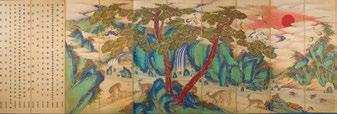
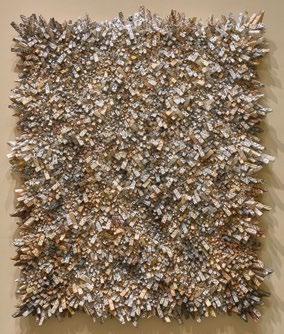










Rethinking Korean Art in the Contemporary Age
Fluid Continuity highlights the narrative of pre-modern to present-day Korean art by interrelating six time-honored traditional art practices and mediums: celadon ceramics of the Goryeo dynasty (918-1392), buncheong ceramics and white porcelains of the Joseon dynasty (1392-1910), and works created using Korean paper, silk, and wood. The aim of this exhibition is to reenvision Korean art history since the turn of the 20th century (which is often addressed in a linear fashion with a series of divided timeframes) as a continuous multifaceted story comprised of rich cultural heritages and influences and their modern interpretations.
The Wan Koo and Young Ja Huh Wing Gallery presents an exploration of Korean ceramics created in various forms by traditional craftsmen and modern artists. Beginning as early, unglazed utilitarian objects, Korean ceramics evolved over time into the ethereal bluishgreen celadon vessels of the Goryeo dynasty and later into rustic buncheong wares and refined white porcelains of the Joseon dynasty. Contemporary artists still engage with these hallowed ceramic traditions, reinterpreting them through a modern lens. The continuous use of clay in Korea reflects its versatility and endless possibilities for artistic expression.
The Jin Joo Gallery features a diverse constellation of objects made of Korean paper, wood, and silk, including Joseon-dynasty folding screens, costumes, and furniture, as well as contemporary paintings, calligraphy, and mixed media works. Each section presents the given material’s artistic and cultural significance, ranging from its production, distribution, crafts, and uses during the late Joseon to its current aesthetic adaptation and transformation. As the late 19th-early 20th century marked a significant transition between tradition and modernization in Korea, the earlier works offer a rigorous survey of historical and cultural context, whereas the contemporary ones provide insight into each artist’s individual practice and philosophy inspired by Korean and modern cultures.
Fluid Continuity reinterprets Korean art with fresh perspective, creating the aesthetic and conceptual dialogue between premodern and contemporary art within a continuous lineage. The exhibition was curated by Soojin Jeong, the JSMA’s 2023-2025 Post-Graduate Curatorial Fellow in East Asian Art, as well as Suhyun Hwang, 2024-2025 JSMA/Korea Foundation Global Challengers Museum Intern.
유동하는 지속성 현대적 시선으로 다시 바라보는 한국 미술
조던 슈니처 미술관의 2025-2026 한국 미술 전시 <유동하는 지속성: 현대적 시선으로
다시 바라보는 한국 미술>은 전근대부터 현대에 이르는 한국 미술의 서사를 한국 고유 의 여섯 가지 미술 양식과 재료들을 서로 연결함으로써 재조명합니다. 이에는 조선시대 백자와 분청사기 그리고 고려청자로부터 기인한 도예 작품들과 한지와 비단, 그리고 목 재를 사용한 작품들이 있습니다. 본 전시의 목적은 20세기 전후의 한국 미술사를 풍부 한 문화유산과 영향, 그리고 그에 대한 현대적 해석들로 다양하게 이루어진 역사로 새롭 게 조망하는 데 있습니다.
허완구·영자 전시관에서는 전통의 시기부터 현대 시점까지 다양한 형태로 제작된 한국 도예 작품들에 주목합니다. 한국의 도자기는 일상 기물로서 제작되기 시작하여, 고려청 자의 은은한 비색부터 분청사기의 독특한 미감과 조선백자의 단아함까지 시대에 따라 다른 미감을 반영하여 발전해 왔습니다. 현대의 작가들은 이러한 재료를 단순히 과거 의 것으로 다루지 않고, 동시대적인 감각으로 새롭게 탐구합니다. 이러한 예술적 표현 의 재료로서 도자의 사용은 한국 미술에서 지속적으로 찾아볼 수 있으며, 앞으로의 예 술적 표현 방식에도 새로운 가능성을 제시합니다.
진주갤러리에서는 한지와 목재, 그리고 비단으로 창작된 전시품들을 선보이며, 조선시 대 병풍, 의복, 가구 등의 문화재들부터 현대의 회화, 서예, 그리고 혼합 매체 작업까지 다양한 범위의 작품들이 전시됩니다. 각 부문에서는 재료가 미적이고 문화적인 맥락에 서 다양하게 활용된 점에 주목하는데, 이에는 조선시대에 이루어진 재료의 생산, 유통, 공예미술 및 용도의 역사적 배경부터 현시대의 미적인 변형과 적용의 예시들까지 포함 됩니다. 19세기 말-20세기 초의 시기가 한국에서 전통과 근대화의 중요한 전환점이 됨 에 따라, 전근대 작품들은 역사·문화적 맥락의 엄격한 조사를 선보이는 한편, 현대 작품 들은 한국과 근현대 문화에 모두 영향을 받은 각 작가의 개인적인 작업과 철학에 대한 통 찰을 제공합니다.
결과적으로 <유동하는 지속성> 전시는 새로운 관점으로 한국미술을 재해석하는데, 이 는 곧 ‘고유의 재료와 문화의 지속적인 계보’라는 주제 안에서 전근대와 현대 미술의 미 적·관념적인 담론의 장을 마련해주는 것입니다. 본 전시는 2023-2025 동아시아 미술 큐레이터 펠로우 정수진과 2024-2025 JSMA/한국국제교류재단 글로벌 챌린저 박물관 인턴 황수현에 의해 공동 기획되었습니다.
“Celadon” is an imprecise term used to designate (mostly Asian) ceramics characterized by blue-green glazes created by coating clay forms containing a small amount of iron with a feldspar glaze containing approximately 1%-3% iron and firing them in a reduction atmosphere at temperatures between 2,282°-2,372°F (1,250°-1,300°C). Celadon ceramics originated in China in the 1st millenium BCE with accidentally glazed pieces, but over time artists were able to apply and control glazes to produce a range of colors and artistic effects. Korean ceramicists further adapted production techniques to develop their own styles of celadon, which are celebrated for their beautiful bluishgreen color, known as bisaek, and reached a peak during the Goryeo dynasty (918-1392). Celadons were mainly produced in kilns located in Gangjin and Buan, Jeolla province from the 9th century, reaching a golden age during the 12th and 13th centuries. Mainly used to create elegant tea vessels, tableware, containers, and tiles, Goryeo celadons were often enlivened with decorative techniques such as incising or relief carving. The most renowned Korean celadon decorative technique is inlay (sanggam), which was unique. The ethereal, otherworldly color of Goryeo celadon was so remarkable that even Chinese connoisseurs praised it highly.
In the early 20th century, interest in celadon increased as historical sites were excavated. Because it resonated with the tastes of Korean art collectors, its popularity grew once again. This led to numerous efforts to recreate the ethereal color of Goryeo celadon, in particular, attempts to replicate traditional kilns or to match the iron content necessary to reproduce the traditional bisaek hue.
In the 1960s-70s, celadon production was revitalized as part of Korea’s traditional culture restoration policies. In contemporary times, many artists create works that reinterpret celadon, breaking away from traditional forms and using it as a medium for their own artistic expression. This section highlights a variety of celadons of various dates, a Horn Cup and Lobed Circular Bowl from the Goryeo dynasty, early 20th-century bowls, and modern works such as a Round Bottle with Slender Flaring Neck and Flying Crane Decoration by Shin Sang-ho and Sitting by the Lakeside by You Heh-Ja.

This deep bowl with a wide, flared rim has a large circular design and lotus pattern engraved on the flat interior surface. The exterior of the body is decorated with six evenly spaced vertical lines, dividing the surface into petal-like sections. The foot is tall and slightly flared in a trumpet shape, with some cracks formed during the firing process. Based on its form and decorative characteristics, this bowl may have originally been part of a lidded set.

Horn Cup with Chrysanthemum Design (菊花文馬上杯, 국화문마상배, Gukhwamun masangbae). Korean; Goryeo dynasty, 12th century. Inlaid celadon ware (sanggam): light gray stoneware with celadon glaze over decoration inlaid in black and white slip. Transfer from Study Collection, 1993:4
This is a unique type of late Goryeo-dynasty (918-1392) wine cup designed with a pointed bottom that prevents it from being set down. This suggests that it was mainly used for toasts at banquets or on the battlefield, where drinkers would empty their cups and then turn them upside down to show they were empty. This Goryeo celadon cup features the refined inlay (sanggam) technique, with white-inlaid thunder patterns on the rim, chrysanthemum motifs on the body, and lotus petal designs on the base. Primarily produced at the Yucheon-ri kilns in Buan, North Jeolla province, these cups were widely made in the 13th century but gradually disappeared thereafter.


These celadon bowls, produced in the early 20th century, have short linear patterns repeatedly impressed on their exteriors using a sharp tool. During this period, the excavation and investigation of Korean art by Japanese archaeologists and art historians, along with the influence of Japanese collectors, led to a widespread appreciation for celadons of the Goryeo dynasty (918-1392). As a result, research and various technological experiments (such as adjusting the iron content and other elements) were conducted to replicate the distinctive jade-green hue (bisaek) of Goryeo celadon. These efforts laid an important foundation for the development of Korean ceramics in the latter half of the 20th century.

A celadon bottle with a voluptuous round body and a narrow mouth, this is an early work by Shin Sang-ho, a contemporary Korean ceramicist and former Dean of the College of Fine Arts at Hongik University in Seoul. Created using the sanggam inlay technique with a crane motif and covered with glaze, this dramatic piece exemplifies Shin’s artistic approach. Shin sought to reinterpret traditional Korean ceramic techniques through contemporary aesthetics. Following his own philosophy of never recreating what had already been made, he continuously pursued new artistic experiments. His works uniquely blend traditional Korean ceramic techniques with a modern sculptural sensibility, showcasing the past through a contemporary lens. This Round Bottle was inspired by the inlaid celadon of the 13th century but incorporates influence from painting. During the Goryeo period, ceramics often emphasized graceful curves and featured motifs such as wild chrysanthemums and cranes. In this piece, the pale blue-green surface is imagined as a vast sky, with a soaring crane in flight.
Mechanical and Electrical
Factory Dormitory, Shenyang

You Heh Ja’s works are deeply inspired by nature, incorporating natural motifs and patterns. She reinterprets traditional Korean designs, such as lotus flowers, lotus leaves, and fish, through a contemporary lens, showcasing a unique painterly expression that bridges traditional and modern aesthetics. In Sitting by the Lakeside, she depicts in celadon the scenery of a lakeshore using various motifs through both relief and incising techniques. By reinterpreting the lotus commonly used in traditional Korean ceramics, she infuses her emotions and inner world into her work. You developed a distinctive style by integrating pictorial elements into her ceramics. Her creations maintain forms that can be used in daily life while expanding into pictorial expressions. In this way, her works maintain tradition while offering a contemporary aesthetic.
Buncheong ware is a type of Korean stoneware that was produced during the first 200 years of the Joseon dynasty (1392-1910). It was made by covering the surface of a vessel’s gray clay body with white slip (refined white clay) and then decorating it using carving, stamping, or brushwork before glazing and firing it in a reduction kiln. The clay used to create buncheong ware is similar to that used to make Korean celadon, but it is darker in color.
The term Buncheong was coined in the 1930s by Korean art historian KO Yuseop (1905-1944) as an abbreviation of bunjang hoecheong sagi, which means “gray-blue ceramics decorated with white slip.” Buncheong’s distinct characteristic is its white surface decoration. There are various methods of surface decoration used to produce buncheong ware. One is stamping, in which a stamp is used to create repetitive patterns, and the patterned areas are filled with white clay. Other techniques include incising, sgraffito (carving through a layer of light slip to reveal the darker clay beneath), iron painting, brushed white slip, and dipped white slip. In particular, dipped white slip serves both as a means of creating patterns and as a process that shows the transition from buncheong to white porcelain.
Buncheong ware developed under the influence of late Goryeo celadon and flourished throughout the 15th and 16th centuries. In contrast to celadon, which had been primarily produced in specific kilns for particular users and markets, buncheong wares were created across the Korean peninsula and catered to all social classes. They served a wide range of functions, from court rituals to everyday household items. The shapes of buncheong vessels are typically round and practical, offering a sense of stability. Although production ceased in Korea after the late 16th century due to the Japanese Invasions (1592-1598), buncheong went on to influence Japanese ceramic production.
Today, the rustic and audacious aesthetics of buncheong continue to inspire contemporary artists who create contemporary works by utilizing traditional techniques and incorporating modern values. In this section are introduced works such as a Bottle and Bowl from the Joseon period, as well as modern reinterpretations of buncheong, including a Circular Bowl by Yoo Byeong-ho and Choi Sung-jae’s Dawn.

The rim of this small bottle flares out, gradually widening from narrow neck to upper body before constricting toward its base. The upward-facing surface is decorated using the brush slip technique, a method of enlivening buncheong ceramics in which a wide brush is used to apply white slip in rapid strokes to the vessel surface. One characteristic of this technique is the rough texture created by the coarse brush, which results in an uneven slip application. Over the white slip layer, iron oxide was used to paint free-wheeling arabesques bounded by horizontal lines. This bottle exemplifies the unrefined character and expressive form of buncheong aesthetics.
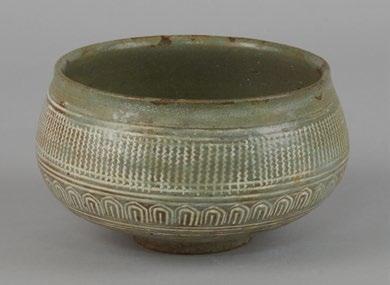
This bowl with stamped decoration features a gentle inward curve from the widest point of its body to its rim. The grayish clay is decorated with stamped designs filled with white slip and coated overall with a thick layer of pale green glaze. The upper exterior surface is adorned with repetitive stamped patterns, while the lower extremities are encircled by a band of stylized lotus petals. The stamped sections were inlaid with white slip before glazing, creating a deliberate contrast to the vessel’s darker clay body. This decorative technique developed from the inlay (sanggam) technique of the celadon tradition in the Goryeo-dynasty (918-1392) but evolved into a more rustic and unrefined style in buncheong ware. This type of stamped inlay is typical of buncheong, exemplifying the Korean aesthetic of embracing simplicity while showcasing remarkable craftsmanship through nuanced surface decoration.

Yoo Byung-Ho is a Korean ceramic artist actively promoting Korean traditional culture in the United States, Japan, and elsewhere. Known for creating ceramics using purely traditional techniques, he strives to capture the sentiments of the Korean people. He primarily employs decorative techniques such as comb patterns, stamped patterns, iron-painted designs, and brushed white slip decoration. By harmonizing these traditional elements with modern aesthetics, he creates a unique world of ceramic art. Yoo’s surface patterns are particularly delicate and complex, showcasing his meticulous craftsmanship. For instance, he meticulously applied the buncheong stamping technique on both the interior and exterior of this bowl, creating an intricate decorative effect. He prefers to use naturalistic colors, seeking to preserve the inherent textures and hues of nature. By integrating this approach with contemporary sensibilities, he continues to expand the boundaries of Korean ceramic art.

Choi Seong-jae is a professor of ceramics who seeks harmony between form and ceramic painting (陶畵). He creates images on his buncheong vessels by applying white slip and using his fingers or tools such as tree branches to scrape through the slip surface, utilizing the contrast between the gray clay and lighter coating, both covered with celadon glaze before firing. While his painterly images are typically simple, their arrangement lends an abstract quality. Choi’s expressive techniques demonstrate his capacity skillfully reinterpret the rustic aesthetic of buncheong in a contemporary context.
CHOI Sung-Jae, 崔成在, 최성재 (born 1962). Korean; Republic of Korea, 2001. Dawn [새벽, Saebyeok]. Buncheong type ware; light gray stoneware with pale celadon glaze over stamped decoration incised through brushed white slip Gift of the Artist with assistance by International Arts & Artists, the Korea Foundation, and the E. Rhodes and Leona B. Carpenter Foundation, 2010:1.3
White porcelain is made from highly-refined clay including white clay mineral (kaolin) and feldspathic rock (petunse), covered with a colorless, transparent glaze, and fired at temperatures ranging from 2,372°-2,462°F (1,300°C to 1,350°C), a tradition that originated in China in the 1st century CE. In Korea, porcelain is associated with the Joseon dynasty (1392-1910) and widely recognized as the representative ceramic of that period. White porcelain developed primarily within the Joseon court and the scholar-official class, being used for various purposes such as tableware and items for the scholar’s studio. Joseon porcelain is characterized by the beauty and modesty of its forms and the minimal use of color.
In the early Joseon, the government preferred white porcelain and designated it as the official ware for the court and government offices. Particularly high-quality porcelains (ceremonial vessels, crafts, and ritual items for the aristocracy) were produced in government-operated kilns in Bunwon, located in Gwangju, Gyeonggi province, near the capital Hanyang. However, from 1592-1598, Japanese invasions devastated the country, and Korea’s ceramic industry experienced a significant decline. Nevertheless, beginning in the late 17th and continuing into the 18th century, white porcelain began to diversify. It was used not only in the court and government offices but also by the general public for ritual purposes. Stationery items such as water droppers and brush holders were also made of porcelain. Additionally, decorative forms such as blueand-white porcelain (cheonghwa baekja) and iron-brown porcelain (cheolhwa baekja) became popular, leading to a broader range of artistic expression.
In modern times, white porcelain has been elevated beyond a traditional craft and enjoys pride of place in the realms of contemporary ceramics and the visual arts. Korean ceramicists have reinterpreted traditional techniques in a modern context, creating new works of art with white porcelain, which have gained international recognition. This section explores the evolution of Korean porcelain from the Joseon period to the 21st century. It includes Joseon works such as a White Porcelain Jar, Faceted Blue and White Bottle, and Water Droppers, as well as contemporary creations that reinterpret the material, such as Fluted Vase, Circular Water Dropper, and Small Brush Rest by Lee Young-Ho, and 1977 Happy Birthday by Hong Soon-jung.
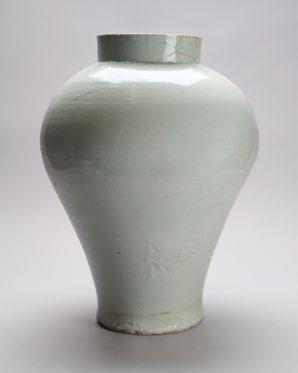
This white porcelain jar has no decoration and features a straight, upright mouth. Its shape gradually narrows from the rounded shoulders to the lower body. In the late Joseon period (1392-1910), as exemplified by this vessel, jars tended to have upright mouths, with shoulders swelling boldly before tapering sharply toward the base. This jar shows evidence of where its upper and lower parts were joined. The lower part flares subtly outward near the foot and is carved from the bottom and it bears visible marks on its base from sand supports used during firing, along with an underglaze cobalt-blue inscription reading “ryul” (栗), which probably indicates the office or consumers with which it was associated. Excavations suggest that this excellent example of undecorated late-Joseon white porcelain was made during the 17th or 18th century in the official kilns of Sindae-ri, Gwangju, Gyeonggi province.

Faceted Blue and White Bottle (白磁靑畫甁, 백자청화병, Baekja cheonghwa byeong) with Floral Design. Korean; Joseon dynasty or Colonial period, late 19th-early 20th century. Porcelain with underglaze blue decoration Gift of John and Kyungsook Cho Gregor, 2017:49.16
This blue-and-white porcelain bottle features a faceted body, with its broad lower portion smoothly transitioning into a long, narrow neck. The base is inscribed with the Chinese character “Ahn” (安), and the body is decorated on the front and back with orchid plants painted in cobalt blue. Compared to buncheong wares of the earlier Joseon dynasty (1392-1910) or celadons of Goryeo dynasty (918-1392), the decoration on Joseon porcelain is relatively simple in terms of materials and technique: painting with a brush was the primary decorative method instead of carving or stamping. In particular, the blue-and-white technique, which uses cobalt pigment called hoechung (回靑) to create vibrant blue designs on pure white porcelain, was an important decorative method introduced from China. Porcelain was often decorated with scholarly motifs favored by Confucian elites, such as the Four Gentlemen (four symbolic plants) and grapevines. This bottle serves as a fine example embodying the blue-and-white aesthetic sensibilities unique to Joseon porcelain.
White Porcelain Fish-shaped Water Dropper
White Porcelain Water Dropper with Landscape Design
White Porcelain Water Dropper with Seven Treasures Pattern


White Porcelain Fish-shaped Water Dropper
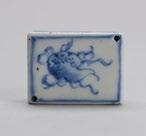
White Porcelain Water Dropper with Landscape Design
White Porcelain Water Dropper with Seven Treasures Pattern
Korean; late Joseon dynasty, 19th century. Blue-and-white ware; porcelain with decoration in underglaze cobalt blue. Loan from the Robert and Sandra Mattielli Collection, L2025:26.2
Water droppers were vessels designed to supply water used to grind ink on an inkstone. They were essential stationery items used by Joseon-dynasty (1392-1910) literati. When practicing calligraphy, controlling the amount of water was crucial, as it determined the density and tone of ink, enabling diverse expressive effects. As the value of literary pursuits increased during the Joseon period, demand grew for water droppers, leading to a rise in production and a wider variety of shapes. Most that survive are made of white porcelain with shapes including circular, square, hexagonal, and octagonal forms, as well as more intricate designs inspired by peaches, persimmons, plants, animals, houses, mountains, etc. Additionally, some were decorated with underglaze blue-and-white designs featuring motifs such as the Four Gentlemen (four symbolic plants), Seven Treasures, or landscapes.
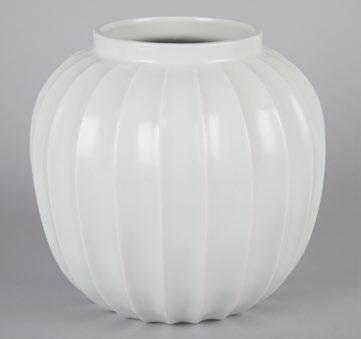
The works of ceramicist Lee Young Ho harmonize practicality and artistry, reinterpreting the beauty of Korean white porcelain with contemporary flair. Devoid of exaggeration or excess, his vessels perfectly embody the Confucian propriety of the Joseon dynasty (1392-1910). Believing that simplicity and brevity are intrinsic to nature and human essence, he allows the inherent beauty of his ceramics to shine with minimal ornamentation.

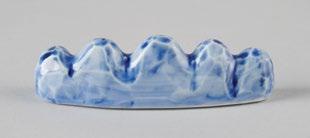
Small Brush Rest (筆架, 필가, Pilga) in the Form of Five Mountain Peaks Blue and white ware; porcelain with inlaid decoration painted in underglaze cobalt blue. Farwest Steel Korean Art Endowment Fund Purchase, 2013:1.1
In his Fluted Vase, Lee stripped away all complexity to capture the essence of earlier porcelains. Rather than showcasing the scale or technical prowess of his work, he demonstrates the austerity and aesthetic purity of traditional Korean porcelain. His Circular Water Dropper and Small Brush Rest revive the literati sensibility of everyday objects. By invoking the unpretentious aesthetics of Joseon porcelain, he strives to bring them into contemporary life.

Hong Soon-jung’s unique artistic expressions combine contemporary sculptural aesthetics with traditional Korean ceramic techniques. She uses clay as a medium to recreate her personal memories. Although the original objects are no longer present, she preserves their essence in ceramic form. 1977 Happy Birthday represents a platter of chestnut sweets from her birthday party. To create it, she first made a plaster mold from actual chestnut sweets, then used that mold to shape balls of white clay before bisque firing them. After applying glaze and firing the “sweets” again, she decorated the ensemble with glittery paint and attached them to a florid stainlesssteel platter. Though the original sweets are no more, their ceramic reconstruction will remain forever in her memory.
Silk is primarily known as a natural protein fiber cultivated and woven to create luxury textiles and clothing. It has been produced and used for various purposes from premodern to contemporary times in Korea, as it became a prominent part of the nation’s market economy in the Joseon dynasty (1392-1910).
Silk cultivation originated in China in the 4th millennium BCE and remained a carefully guarded secret until the 1st millennium CE, eventually making its way east to Korea and Japan and west along the Silk Route to Central Asia and Europe. During the Joseon dynasty, the Korean government implemented policies that suggested sericulture, or silk production, to stabilize the nation’s finances and the lives of the people. Initiatives were conducted to cultivate mulberry fields and weaving was recommended as a Confucian virtue for (especially aristocratic) women. Government facilities produced the highest quality silk to accommodate royal needs, whereas private handicraft manufacturing developed due to the high demand for silk among the nobility.
In the cottage industry, silk threads were produced from the cocoons of silkworms raised on mulberry leaves from trees by noble women who spun the silk and used looms to weave the resulting threads into silk textiles, known as bidan. The textiles were then used primarily to craft garments designed for the producers’ families or sold through markets to maintain and improve the economic circumstances of the families. Compared to the simple cotton and hemp clothing worn by common people, the qualities and prices of silk were relatively high, contributing to its large consumption by the elite.
During the 17th-19th centuries, Korea’s domestic production of high-quality silk reduced substantially due to the rapid increase in the importation of silk from China and other countries. Both the Korean government and private silk industries declined. However, the uses of silk became more broad and diverse, as it served as a significant material for making clothes, as a ground for paintings, and as decorative mountings for scrolls and folding screens. During the Colonial period (1910-1945) when Korea was annexed by Japan and rapidly modernized, silk began to be mass produced in factories. Since that time, it has been utilized for a wide variety of aesthetic purposes, not only in the fashion industry but also in the field of visual art. This section highlights the use of silk in Korea and beyond from the 19th through the 21st centuries, including as the ground for two paintings, a folding screen of the Ten Symbols of Longevity, and a hanging scroll Portrait of a Military Official, as well as in traditional women’s costumes (hanbok) and a contemporary work Circuits – Wrapping Cloth created by an Oregon-based Korean artist.

This exquisite screen exemplifies a type produced by court artists and exchanged between the king and officials for auspicious and decorative purposes during the Joseon dynasty (1392-1910). Such monumental paintings were often displayed behind the throne during royal ceremonies, with a specific selection of landscape, floral, and animal motifs that symbolize wishes for happiness, longevity, and prosperity for the ruler and the nation. In this Ten Symbols screen, the grand scale, meticulous brushwork, and thickly applied mineral pigments are all characteristic of court production. The last two panels are inscribed with the names of fourteen court officials, including many associated with the royal pharmacy responsible for treating Crown Prince Yi Cheok* when he recovered from smallpox after 1879. The screen is believed to have been commissioned by those officials to express their desire for the good health of the only male heir of King/Emperor Gojong (1852-1919). The most distinctive features of the painting are its monumental scale, flat composition, multiple perspectives, richly colored mineral pigments, and asymmetrical, yet balanced, arrangement of elements, which create a harmonious, otherworldly scene.
*Later known as Emperor Sunjong (1874-1926), who ruled Korea from 1907-1910

of a Military Official (武官肖像, 무관초상, Mugwan chosang) Korean; Joseon. dynasty, 18th-19th century. Hanging scroll; ink and color on silk. Murray Warner Collection, MWK32:1
During the Joseon dynasty (1392-1910) Korea’s national ideology of Confucianism fostered a tradition of creating detailed portrait paintings as expressions of respect for ancestors and teachers. As the country began to adopt modern influences through China, Silhak (Korean practical science) inspired by European realism, emerged in science and culture, including visual arts. Adapting the realistic method of EuroAmerican painting technique, many portraits developed more detailed, threedimensional expressions using the Asian method called eumyeongbeop, in which colored ink is gently smudged into a water drop to create subtle shading. In this portrait, the official’s face is delicately painted with shades accentuating the individual physiological features of his skin, whereas his garment is depicted more boldly and flatly, a juxtaposition that highlights the sitter’s face. Additionally, the elements of the chair visible around the figure are painted using linear perspective, appearing to recede toward the background. To stabilize the ink and impart soft color effects, this portrait was painted using a primary coloring method for portraiture called baechaebeop, in which contours were depicted from the back of the silk and filled in on the front. The transparent and yet sturdy qualities of silk make it an ideal support for this painting technique.

This is a classic example of Korean traditional dress known as hanbok that originated in the late Joseon dynasty (1392-1910). It consists of two pieces, a short jeogori (top cloth) and a long skirt, in the kaftan* style with an elegant, curved silhouette, a simplified type that developed since the establishment of modern Korea in 1953. Beauty and moderation are here expressed through plain blue and white – two of the five cardinal colors that signify the yin-yang theory and the five elements, essential principles in East Asian thought. The modest, curved design also reflects human admiration for nature, which was a common sentiment during the Joseon dynasty. For aesthetic balance with design, hanboks were often woven of materials such as silk, cotton, or linen; in this example, the high-quality of the plain-weave tetron polyester resembles the transparency and glowing surface color of silk, but in an updated, man-made fabric.
*Kaftan: a garment with long sleeves worn by ancient northern Asian nomads

(薄絹襦裳, 모시저고리와 치마, Mosi
Hanbok began to be modernized during Korea’s Colonial period (1910-1945), when patriotic enlightenment activists founded many schools and organizations for new education to reclaim the sovereignty of the nation. As the social activities of highly educated women increased, they started wearing clothing updated for convenience and practicality - their skirts became shorter, and the lengths of their tops (jeogori) were elongated. When compared to the other hanbok displayed nearby, this costume clearly exemplifies these modifications not just in the adjustments of those elements, but also with its unique, modern design, color pattern, and use of linen. The exotic overlapping roundel pattern on the skirt reflects Japanese influence and the edges of the jacket are decorated with seven meticulously embroidered “luck” (福) characters. The overall curved silhouette of hanbok from the Joseon dynasty (1392-1910) has been straightened, which resembles ordinary contemporary clothing.

Through the slow, meditative process of fiber-making, Jiseon Lee Isbara explores her identity and experience as a female immigrant artist in the United States, weaving her memories, emotions, labor, and time into her art. For Isbara, the nostalgic material resonates with her family history, evoking memories of her grandmother, who routinely practiced embroidery during her childhood. The artist’s repetitive practice embodies her everyday challenge situated between diverse cultural and social spheres. As weaving, itself, entails a struggle to shape materials, Isbara’s lived experience in three cultures (Korean, American, and Turkish) challenges her to address herself in the midst of expectations she encounters as an artist, academic, and mother. For her, fiber-making is a calm, meditative process, one in which she collects, embeds, interweaves, and spreads her ideas about different identities and experiences.
In premodern Korean culture, wood was a common, familiar resource highly cherished to produce architectural structures such as houses, palaces, and temples. Elegant wooden furniture was appreciated by the elite and commoners alike during the Joseon dynasty (1392-1910).
Beginning in the late 14th century, the Korean government designated certain forests and mountains as national properties and prohibited lumber harvesting in those domains to secure natural resources for national use and maintain luxuriant greenery surrounding the capital. Because of these policies, the central government workshops that specialized in the production of furniture and wooden objects was able to secure materials and continuously develop techniques in response to the demands of the nobility. The noble class were the people who afforded luxurious furniture designed for the tastes of imperial families. This industry prospered until the late 16th century, when the economy began to decline precipitously after the Japanese Invasion of Korea (1592-1598).
Despite these challenges, the woodworking industry entered a transitional period, as Korea’s social stratification reforms and the emergence of a nascent market economy gave rise to new wealthy classes of artisans and consumers. The new craftsmen owned private workshops and produced public goods and agricultural implements, as well as luxury furniture for the aristocratic class. This continued until the early 18th century, resulting in the development of private enterprise as the government industry’s handicraft techniques, supplies, production, and distribution were transferred into private hands. This development also accelerated due to the costume revolution, in which the loosening of hierarchical dress codes resulted in an increasing need for household storage furniture such as chests and closets.
The market for wooden furniture expanded by the late 19th century with the increase in consumers with improved living conditions so that high-end products were produced and distributed to the public regardless of their social status. Today, wood serves as a primary or supplementary materials for multiple art and design purposes. This section presents classic examples of late Joseon furniture, along with modern painting and calligraphy works on wooden supports that enrich Korean-ness of their subject matters. It includes a Storage Chest and Table made of lacquered wood with mother-of-pearl inlay, elegant Tray Tables for dining, a two-tiered Wooden Chest, a Seated Buddha statue, Ik-Joong Kang’s painting called Happy Buddha, and Jung Do-jun’s calligraphic work entitled Laozi, Daodejing, Chapter 51

This ornamental Wood Chest is an example of storage furniture that was designed to store clothes, blankets, and fabrics used by women, often installed in a main room of a household during the Joseon dynasty (1392-1910). By the late Joseon, the production of such furniture increased due to the costume revolution through which the reduction of national sartorial regulations occurred and caused an expansion in the production and sale of textiles. This two-tiered closet, known as yicheung nong, is a type developed from a transportable chest called a gori nong (ring chest) that has an openable cover with a metal ring-shaped knob on top. Its singular structure has been developed into a two-tiered form with hinged doors in the center for convenience. Meanwhile, the decorative fittings made of cupronickel take the form of a butterflyshaped lock plate and hinges, as well as an auspicious symbol knob and angle ties, which imply wishes for prosperity and longevity. The use of zelkova wood and cupronickel fittings, and the plain, even surfaced panels suggest that this chest was created in the city of Tongyeong in South Gyeongsang province.

This statue was carved from a single piece of wood using the single-block carving technique. The tree’s natural grain and tree rings are clearly visible. The piece is made of pine, a type of wood widely used to create Buddhist sculptures due to its ease of carving and durability. The Buddha is depicted in a seated position, meditating peacefully with half-closed eyes and a gentle smile. The figure’s head is large in proportion to its body, with hair sculpted in tiny spiral curls (nabal). While many Korean Buddhist statues were gilded, this one was not, which allows the natural texture of the wood to be appreciated. The absence of gilding may have been an artistic choice or may suggest that this work was intended for private devotion rather than worship in a temple.

Ik-Joong KANG (KANG Ik-Joong, 姜益中, 강익중; Korean-born American, born 1960). Happy Buddha (행복한 부처, Hangbokhan Bucheo), 2007. Crayon and tempera on pine board with Envirotex Lite polymer coating. James and Haya Wallace Acquisition Fund Purchase, 2008:13.1
A globally celebrated artist, Ik-Joong Kang is renowned for monumental assemblages of drawings/paintings on three-by-three-inch canvases/wooden boards, often shrouding massive walls. Living and working in New York as an immigrant since 1984, he began to use thousands of small square forms as his canvas early in his career; he routinely carried and depicted daily views of the city on them in subways amid a hectic life. The cityscapes subsequently transitioned to images of Buddhas, Korean ceramics, the Korean hangeul alphabet, drawings of children, and more that communicated his ideas to global audiences. Happy Buddha is a framed series of 100 tiny paintings that embody images of the Buddha, which Kang viewed as his Korean identity embracing diverse inspirations in the pursuit of wisdom in an international, American culture. The Buddhas painted in various colors, including the obangsaek (five cardinal colors in Confucianism), reflect his Korean tradition that has vigorously interacted with the hybrid culture in globalized society since 1992. Kang’s use of wood reflects his filial affection for his visually impaired father, as he intends his art to be physically sensed through the touch of his father’s hands.

JUNG Do-jun, 鄭道準, 정도준 (aka So-heon, 紹軒, 소헌; born 1948). Korean; Republic of Korea, 2006. Lao Zi (老子, 노자, Noja), Daodejing (道德經, 도덕경, Dodeokkyung), Chapter 51 Framed calligraphy in Chinese characters on laced slats; ink on wood. Murray Warner Acquisition Fund Purchase, 2007:2.3
Jung Do-jun is an acclaimed contemporary calligrapher renowned for his original practice that merges inherited Asian calligraphic traditions with innovative artistic expressions. Building his own aesthetic language, many of his works feature characters written in seal script (one of the oldest form of Chinese characters) and hangeul (Korea’s phonetic syllabary). In this work, he transcribed verses from Chapter 51 of the Daodejing, a foundational Chinese Daoist text attributed to the semilegendary figure Lao Zi (6th century BCE), in stylized seal script Chinese characters. The rows of elaborate, aesthetic characters are elegantly balanced on the series of vertical wooden slats, lending an austere and sacred sensibility in a rigorous fashion. This implies a contradictory balance between his liberal expression and rigid control. Jung’s use of wooden slats references the custom that was prevalent before paper developed in China around the 2nd century BCE, when texts were written from top to bottom and right to left on vertical strips of bamboo strung together to create long horizontal texts, which could be rolled up for storage (a precursor to the horizontal handscroll format). Likewise, such bamboo rolls would also have been used during Korea’s Three Kingdoms period (57 BCE-668 CE) before Korean paper production developed during the Goryeo dynasty (918-1392).


These Tray Tables (soban) exemplify a type of Korean dining table that became popular during the Joseon dynasty (1392-1910) when lifestyles became more sedentary due to the adoption of both Neo-Confucian social hierarchy and the ondol floor-heating system. In the late Joseon, Confucian ideals were reinvigorated. According to this newly enforced value system, a differentiation between genders and ages characterized social life, which led to divisions of space and dining customs according to gender and hierarchy in the homes of noble families. For example, the kitchen was used only by women, whereas men could dine independently in their rooms. The small, light-weight quality of these tray tables represent how they, with full meals on top, were carried by women from the kitchen to other rooms. Known as hojokban, because their sturdy, agile-shaped legs resemble those of a tiger (ho), these examples with twelve-sided tops were the kind widely used across the nation, excluding South Jeolla province.

These Storage Chests are exquisite examples of furniture made of lacquered wood with mother-of-pearl inlay produced and popularized during the late Joseon dynasty (1392-1910). The inlay technique originated in the Goryeo dynasty (918-1392), which began with luxurious motifs derived from Buddhism and later developed with more practical, simple decorations. This type of furniture was confined to chests called ham, produced and used exclusively at court in the early Joseon, whereas later examples were produced and distributed by private workshops that catered to the tastes of the newly formed upper classes. These chests also show how folkloric motifs were used as ornamental patterns, reflecting the auspicious tradition popular among the public. Inlaid on either side of the front door panels, the patterns of clouds, sun and moon, pines, deer, cranes, and bamboo signify longevity, while on the lower parts of each tier, peaches, chrysanthemums, and peonies symbolize prosperity. The primary Korean source of mother-of-pearl is abalone shells collected from Gyeongsang, Jeolla, and Gangwon provinces by the ocean. Craftsmen pulverize or carve pieces of these shells into shapes to embed into cavities engraved in the wooden structures.

Table (經床, 경상, Gyeongsang). Chinese; Unknown. Lacquered wood with mother-of-pearl inlay. Murray Warner Collection, MWK13:6
Korean paper, or hanji, is produced using a traditional manual method that originated in China in the 2nd century BCE. Bast fibers from mulberry trees are dispersed in water and then filtered through a woven bamboo tray to shape individual sheets of paper. Due to the long, elaborate process of cutting, steaming, boiling, peeling, pounding, shaping, and drying the mulberry branches, it requires an artisan’s advanced hand skills as well as a significant commitment of time and labor. The cultural value of hanji has been globally recognized, as eight of eleven Korean UNESCO World Memory Heritages were created using Korean paper, including the oldest (The Great Dharani Sutra of Clear and Pure Light, called Mugujeonggwang Daedaranigyeong) that dates to the 8th century.
Though the genesis of Korea’s paper production dates from the Three Kingdoms period (1st-7th centuries), its mass production and industry began to develop at the beginning of the Joseon dynasty (1392-1910), when the government established its first papermaking facility to produce mulberry paper currency. Because Confucianism was the national ideology, this facility produced paper mostly for royal, governmental, and diplomatic products, especially scriptures, anthologies, and books that disseminated Confucian knowledge and teachings among the royal family and aristocracy. This led to a stable production of high-quality paper with steady technical advancements through the mid-Joseon period.
During the 15th century, the quality and productivity of Korean paper began to decline due in large part to increasing demands from China for tribute. As Korea endured more economic hardships after Japanese military invasions in 1592 and 1597, the supplies of both mulberry trees and skilled artisans were substantially reduced, which resulted in the discontinuity of the government-managed paper industry in the late Joseon period. Despite and due to this phenomenon, there was an opportunity for private industry to develop with the rise of the market economy. The public demand for paper began to increase during the late 18th century “Korean Renaissance”, as scholars wrote more publications and more liberal public exchanges occurred through markets formed around the capital city, Hanyang.
Today, Korean paper is acknowledged for its nature-friendly quality and durability due to its lightfastness made possible by its high-cellulose content. Produced in specialized workshops managed by master craftsmen who are registered as intangible cultural properties, hanji is one of the most significant inherited materials that embody the convergence of traditional and modern Korea in art and design. This section sheds light on works made with Korean paper from the Joseon dynasty to the present, including The Doctrine of the Mean (a Chinese Confucian book translated in Korean), a folding screen depicting Scholar’s Accouterments, as well as two contemporary works inspired by modern and Korean cultures, Aggregation 17 - DE098 and Forever Couplehood II.
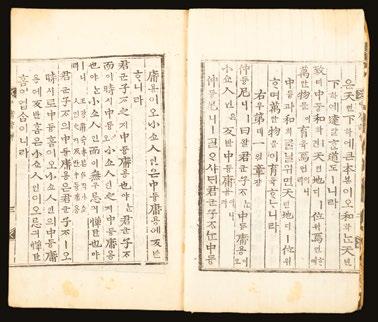
Commentary and Explanations of the Doctrine of the Mean (中庸諺解, 중용언해, Jungyong eonhae), Korean Translated Edition Korean; Joseon dynasty, 1810 (originally published 1590). Thread-bound woodblock-printed book; ink on paper. Museum Collection, XDXX3
The Doctrine of the Mean (中庸, Zhongyong), which originally dates from the 1st millenium BCE, is one of the Four Books and Five Classics, exemplary Chinese Confucian books of education and refinement that were ordered to be transcribed and translated into Korean in 1584 by King Seonjo (1552-1608). Renowned as a foundational teaching in Confucianism, the “mean” (中庸), in other words “moderation,” signifies appropriate harmonious behavior to others with self-reflection of words, acts, and emotional expressions. Since its original Korean translation, published in 1590, the Doctrine of the Mean was republished in many slightly revised versions at central and rural printing facilities managed by the Joseon government. In this edition, each line written in Chinese characters is transcribed and translated using the phonetic Korean letters called hangeul. Its production exemplifies the mass publication of Confucian texts printed with woodblocks, a highly advanced, efficient technique that contributed to the distribution of such classics across the nation. Additionally, it implies the broad national dissemination of Confucian studies known as Gyeonghak, a methodology of teaching Confucian ethics.
Beijing 798 Factory

Scholar’s Accouterments (冊巨里圖, 책거리도, Chaekgeorido). Korean;
folding screen; ink and color on paper.
This type of Scholar’s Accouterments screen evolved from a tradition of court painting that was disseminated to the middle and lower classes in the late Joseon dynasty (1392-1910). Unlike court paintings of a unified set of shelves filled with classical Chinese books and luxury goods characterized by shading and seeming recession in space, this screen appears to be made of up eight separate piles of objects resting on tabletops (not in a cabinet), and the prominent inclusion of auspicious items, as well as the unique painting method suggest such a middle-class lineage. The Scholar’s Accouterments painting tradition reflects the penchant of Korean royals, aristocrats, and literati for Confucian scholarship and Chinese antiques, as it presents a diversity of refined objects in a splendid, ornamental manner. Meanwhile, the inclusion of certain auspicious items such as fruits (watermelon, grapes, and pomegranate) and animal (turtle, deer, and crane) -shaped vessels and sculptures symbolizes a tradition in commoner households, as the caste system was reformed during the final years of the dynasty. The bold, detailed application of pigments reveals the absorbent, nonspreading qualities of Korean paper, the significant characteristic for paintings during this period. This screen was constructed by applying multiple layers of Korean paper onto a series of rectangular wooden frames and connecting the panels with thick paper hinges.

In 1995 Chun Kwang Young began his Aggregation series that seeks to embody the ideological and social unities and conflicts that occur throughout human history. Inspired by traditional paper wrappers for medicinal herbs that he recalled from his childhood, Chun creates thousands of triangular pieces of Styrofoam wrapped with Korean-paper (hanji) pages torn from classical books, old newspapers, genealogies, and other items, and assembles them on boards. In Aggregation 17 – DE098, the abstract whirlwind image comprised of particles of historical records evokes the impression of a prehistoric collision of continents subsequently differentiated by geopolitical borders. Dyed with shades of dark pigment, the writings resemble furrows of land, which signify deconstruction. Through such constellations of paper fragments, Chun embodies the modern rebirth of human history and Korean identity, which is created between life and death of conflicting information visualized by craters and flexures on canvas.
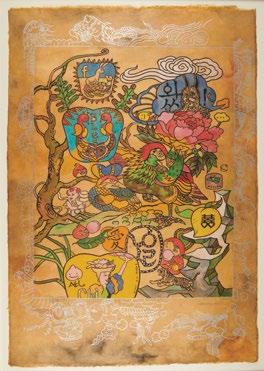
Jiha MOON (MOON Jiha, 문지하; Korean-born American, born 1973). Forever Couplehood II (Day), 2014. Ink and acrylic, screen-printed on hanji paper. Farwest Steel Korean Art Endowment Fund Purchase, 2018:34.2
Diasporic artist Jiha Moon investigates the fluid hybridity of cultural constructs in the global contemporary age by vigorously incorporating diverse icons and symbols from Asian traditions, Euro-American art canons, and digital culture. In Forever Couplehood II, Moon created the vibrant imagery of a dream-like scene in which she explored the theme of couplehood represented by a pair of mandarin ducks that signifies the enduring love of a married couple. The theme is enriched by the assimilation of motifs and characters borrowed from Korean folk art/literature, Disney cartoons, digital brand images, and other contemporary signs. For Moon, the brown Korean paper (hanji) is a hallmark medium that reflects the authenticity of her practice manifested through her Korean/cross-cultural identity, as it evokes the nostalgic sensibility of classical books, antiques, and other historical objects.
The Jordan Schnitzer Museum at the University of Oregon was among the first academic art museums in the US to establish permanent endowed galleries devoted to the arts of Korea. We house a small, but impressive collection of over 500 Korean objects spanning the 1st century BCE through the present and encompassing the categories of painting, calligraphy, ceramics, sculpture, metalwork, textiles, furniture, prints, photographs, and time-based art. The museum is proud to feature thematic exhibitions of historic, modern, and contemporary art in our Wan Koo and Young Ja Huh Wing and Jin Joo Gallery, augmenting the early Korean objects acquired by museum-founder Gertrude Bass Warner with more recent acquisitions and loans from collectors such as Kyungsook Cho Gregor and Robert & Sandra Mattielli. The JSMA also boasts one of the world’s largest collections of prints, paintings, and drawings by the Scottish artist Elizabeth Keith, who recorded many scenes of everyday life in early 20th-century Korea. Over the years, the museum’s educational and exhibition goals have been significantly aided by the Korea Foundation, which has awarded grants to a succession of talented JSMA/KF Global Challengers Museum Interns who garner international museum experience assisting with our Korean exhibitions and projects. Generous support from the Korean National Research Institute of Cultural Heritage and the National Museum of Korea has also made it possible to conserve two of the museum’s important Korean paintings, update our object records and rephotograph our Korean collection, and produce two bilingual (English/Korean) publications.
Fluid Continuity is the result of many months of thoughtful research and planning by Soojin Jeong, the JSMA’s 2023-2025 Post-Graduate Fellow in Asian Art, and Suhyun Hwang, our 2024-2025 JSMA/KF Global Challengers Museum Intern. We are happy and proud to mentor such gifted young scholars and to forefront the fruits of their labor.
Anne Rose Kitagawa Chief Curator of Collections & Asian Art and Director of Academic Programs

The only academic art museum in Oregon accredited by the American Alliance of Museums, the University of Oregon’s Jordan Schnitzer Museum of Art (JSMA) features engaging exhibitions, significant collections of historic and contemporary art, and exciting educational programs that support the university’s academic mission and the diverse interests of its off-campus communities. The JSMA’s collections galleries present selections from its extensive holdings of Chinese, Japanese, Korean and American art. Special exhibitions galleries display works from the collection and on loan, representing many cultures of the world, past and present. The JSMA continues a long tradition of bridging international cultures and offers a welcoming destination for discovery and education centered on artistic expression that deepens the appreciation and understanding of the human condition.